Customer profiles aim to help you understand your audience better and tailor your marketing campaigns and offers to their specific needs and interests. This, in its turn, helps you grow your revenue. In fact, for every dollar marketers spend on promotion, they receive $36 in return.
Why does it make such a difference? Because your audience is more likely to open and respond to email content that is closely aligned with their needs and preferences, all of which customer profiling makes possible.
So what is a customer profile in marketing, and where do you find data to build one? Let’s talk about it and go over the process of developing customer profiles step by step. We will also review several customer profiling examples that can be your inspiration, so make sure to stick around!
What is a customer profile, and why do you need it?
A customer profile is a collective image of your existing customers for whom your product is a perfect solution. This is not just your target audience description — it requires a deeper dive into various customer segments’ demographics, buying habits, pain points, and more. Although these are made-up people, the information used for customer profiling is gathered from real customers and their actual needs.
By developing a complex and situation-specific customer profile, you can:
- immediately spot customers for whom your product is an excellent fit and reach out to them with ease and confidence;
- сreate relevant discount campaigns, emails, ads, and content on your website based on your buyers’ specific preferences and prepare a unique offer that hits the spot;
- choose only the marketing and sales channels where you can actually reach your target audience based on the devices and social media they use the most;
- help your sales team understand if they are talking to a potential buyer or just an interested user and adjust their offer accordingly;
- understand which product your audience loves the most and fine-tune your company’s business development and marketing strategy using customer profiling and segmentation.
Unsurprisingly, customer profiling does not look the same for every company, as no two businesses have perfectly matching goals, needs, and customers. There are, of course, several factors that need to be accounted for in all customer profiles, regardless of the business situation.
What does a customer profile consist of?
There are multiple components that you can potentially include when creating customer profiles. We can divide them into five categories: demographics, geographical factors, psychographics, socioeconomics, and behavioral factors.
Demographics:
- age;
- gender;
- ethnicity;
- nationality;
- religious beliefs;
- marital status.
Examples of demographic data in customer profiling helping accomplish business goals include:
- to sell alcoholic beverages, your ideal customers must be of legal age;
- knowing the marital status of your ideal customers, you can reach out to singles to promote your dating app.
Geographical factors:
- climatic conditions;
- location;
- cultural peculiarities.
Examples of geographical data in customer profiling helping accomplish business goals include:
- knowing the climatic conditions your ideal customers live in, you can sell snowboards and ski equipment to those who can actually use them;
- knowing more about your ideal customers’ culture, you can know whether to greet them with certain holidays. This will help amp up your holiday sale campaigns — Christmas, Valentine’s Day, Diwali, Halloween, or Ramadan.
Psychographics:
- driving emotions;
- motivations;
- interests;
- pain points and challenges;
- values.
Examples of psychographics in customer profiling helping accomplish business goals include:
- knowing your ideal customers’ interests and problems, you can make a unique offer that will solve their problem — gamers who live in small apartments would prefer a powerful laptop that takes up less space over a desktop computer;
- knowing your ideal customers’ interests and problems, you can predict which products will become more popular. Case in point: people’s habit of constantly spinning things in their hands helped fidget spinners become a hit in 2017.
Socioeconomics:
- income level;
- job title;
- education;
- place of residence.
Examples of socioeconomics in customer profiling helping accomplish business goals include:
- knowing your ideal customers’ income level, you will be able to determine which products to label as economy, average, and premium.
- knowing your ideal customers’ profession, you can offer them an online course or a workshop that will level up their skills.
Behavioral factors:
- purchasing reasons;
- average check;
- sales seasonality;
- shopping list.
Examples of behavioral data in customer profiling helping accomplish business goals include:
- knowing what kind of foods your customers buy or the dishes they often meal prep, you can advertise these foods or dishes on the website of your delivery service;
- sales seasonality helps you track the peak of all-season jacket sales.
How to build a customer profile
Even though every company’s customer profiles are different, the method of compiling them is relatively similar for any business. We will run through the process of building customer profiles step by step so that it’s easier for you to understand which tasks to put on your to-do list first.
Step 1. Defining and segmenting your target audience
Chances are you already did this — if you haven’t, pull up a chair. To start with, we will analyze your client base and discover more about those who buy from you, including your clients’ gender, age, location, and purchase frequency. You need this basic information to be able to segment your audience and understand the challenges they face every day before creating customer profiles.
The most effective way to gather these data points is by using your CRM system, social media, and Google Analytics. If you have a physical store, don’t miss the chance to talk to your managers and sales team — they interact with your customers every day and will most definitely have some insights for you. Here are some questions you can focus on:
- What kind of customers shop at your store? Do they shop alone or with someone? If the latter, who makes the purchase decision? Who pays for the goods?
- How do customers approach your in-store managers? Are they frustrated? How often do customers need help choosing a product? What kind of questions do they ask most often?
Next, you need to use this info to segment your customers by gender, age, and location, even if you think your audience is more homogeneous. For example, if you sell products targeted specifically towards men, you will still have female customers who want to buy their male significant other a gift. In this case, you will need two or more separate profiles for better customer profiling and segmentation.
Step 2. Selecting the parameters to be included in your customer profile
Choose a prominent and typical representative for each segment. Then, pick the parameters you want to add to your customer profile, like demographics, geographical factors, psychographics, socioeconomics, and behavioral factors.
You don’t need to cover all the details from each category if they do not bring value when creating customer profiles. For instance, unless your ideal customer’s teamwork abilities or IQ level are crucial to your understanding of how to sell your product better, this info is not really necessary for your customer profile, so don’t waste your time collecting data you will delete eventually.
Still, parameters like location, age, motivation, habits, pain points, purchase reasons, and average check are universal and pertinent to pretty much every customer profile. In any case, your marketing objectives and specific business needs are the only factors that can dictate what you should include and omit when building customer profiles.
Step 3. Gathering, analyzing, and filtering customer data
Once you select the parameters for your customer profile, you have everything you need to start collecting data. It is best when each of your questions in a survey is aimed at collecting information for a specific parameter.
You can gather customer data to build a customer profile using emails, calls, surveys, social media, ads, and more. We will walk you through these effective data collection methods in the next section, so stay put.
Pro tip: If you don’t get the data you need, try conducting an in-depth interview by asking customers to answer a few questions during a phone call.
To encourage customers to complete a survey, you can offer a discount or a freebie in the form of a checklist, guide, or automated webinar. In addition, you can hire a psychology expert to help you analyze the answers received — you will be able to draw up a psychological profile of the user to understand their values and driving emotions, improving your customer profiling and segmentation.
Step 4. Building customer profiles
Finally, turn the information you gathered into a customer profile for each of your audience segments. You can do this manually using Google Slides, Canva, Figma, Adobe Express, etc. This way, you will be able to come up with your own template and structure, not having to work your way around ready-made templates that don’t really suit your needs or don’t have enough space for all of your customer profiling parameters.
In case you don’t need a unique customer profile structure, customer profiling software can be a good shot. With premade customizable templates, you will be able to save time on designing your customer profiles and making them aesthetically pleasing. Use a tool like Xtensio to develop your profiles on the cloud together with the team, share links to them, present them as slideshows, and define your clients’ motivations and brand influencers.
Here is what this customer profiling software looks like:
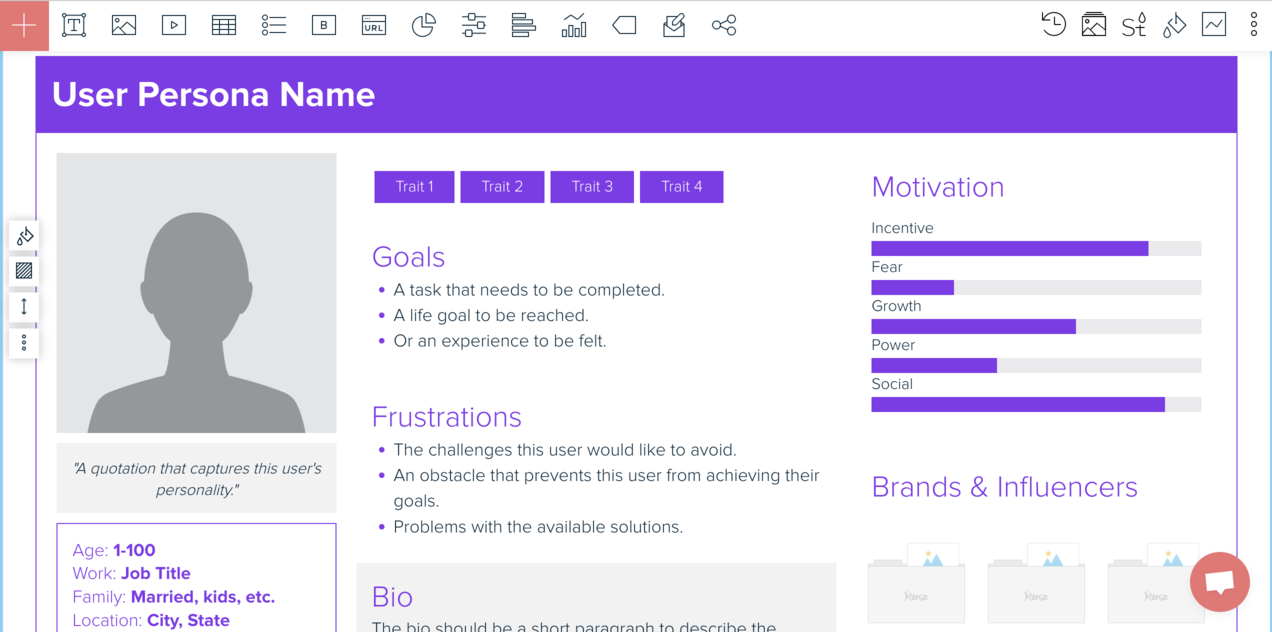 Customer profiling software example
Customer profiling software example
Another customer profiling tool option is UserForge — this solution is much simpler but just as effective. It is perfect if you plan on creating your customer profiles in collaboration with your team, and you can invite your colleagues and stakeholders to contribute.
Here is what this customer profiling software looks like:
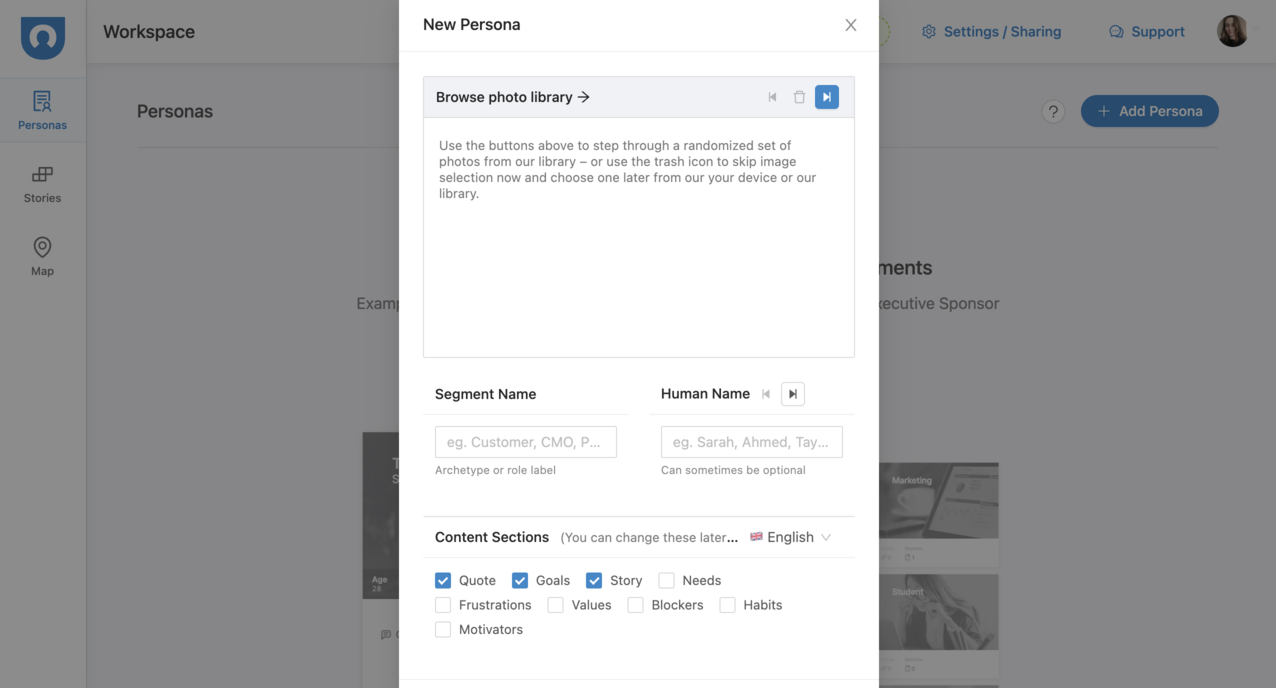 Customer profiling software example
Customer profiling software example
What is also great about customer profiling software is that many of these tools enable you to integrate with other platforms like Jira or Google Analytics. You will be able to update your profiles on the go as your audience grows and changes, simultaneously tracking all the necessary data.
Where to collect data for customer profiling
Now we get to the long and strenuous part — it does not have to be, though. If you have already defined the customer profiling parameters you want to target and know which communication channels your customers prefer, this should be a lot easier for you. Let’s go over some of the ways to gather information for your customer profiles.
Emails and subscription forms
When a user subscribes to your newsletter, have them fill in an additional information form and specify their age, location, job title, and product preferences. Choose only the fields suitable and useful for your email campaign, emphasizing how valuable it is that customers take the time to fill them.
Take a look at a subscription form from American Eagle. This window appears towards the end of the subscription process and helps the company generate personalized emails, segment the mailing list by gender, and build a customer profile.
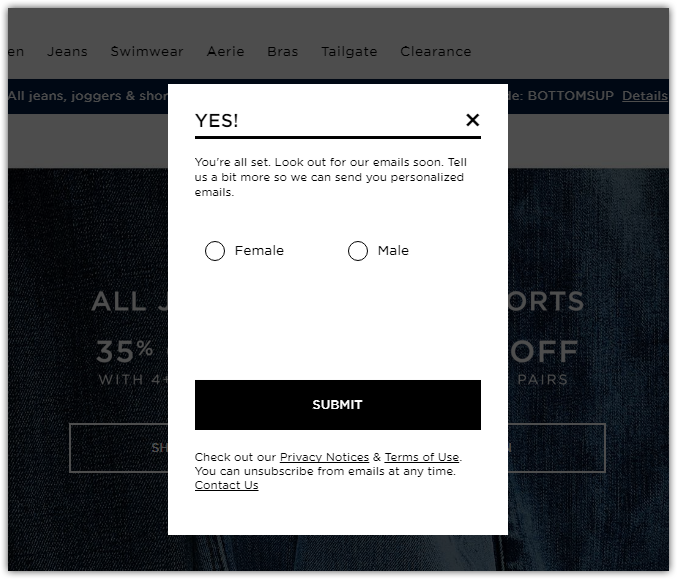 American Eagle collects customers’ data about their gender
American Eagle collects customers’ data about their gender
After a user subscribes, send them a welcome email asking for information about their interests, just like The North Face does. The company asks its subscribers about their favorite ways to explore the world — the answers will help make the newsletter more valuable and engaging.
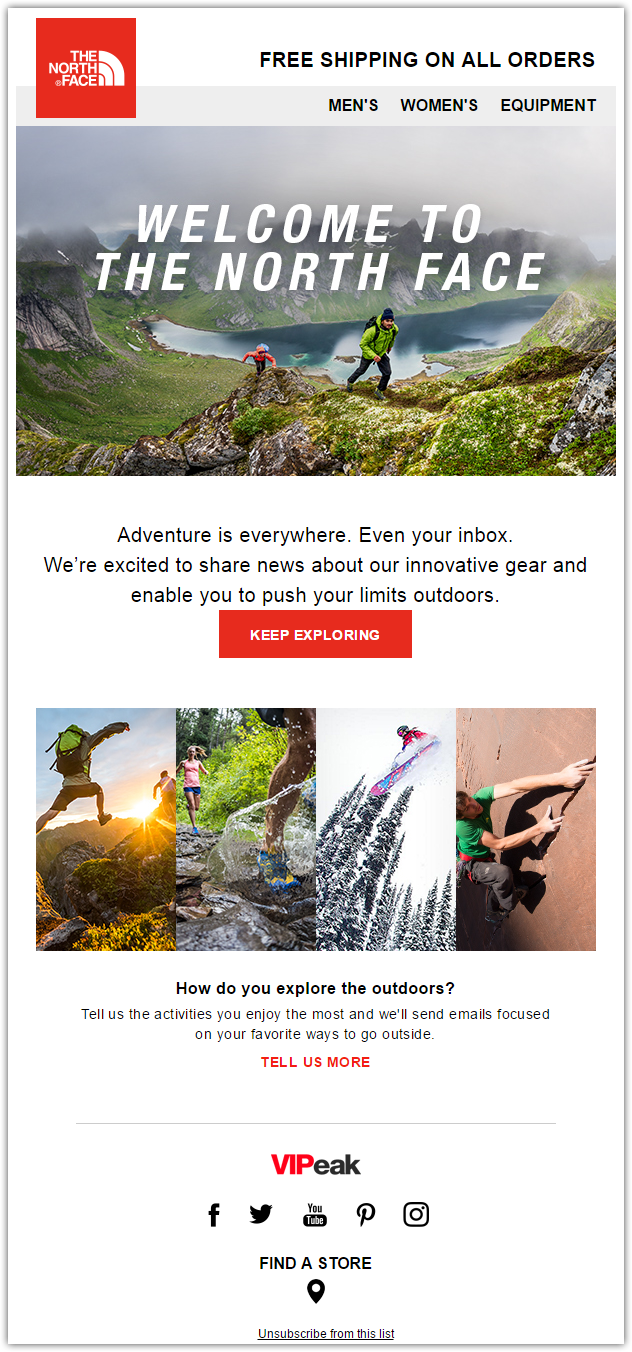 The North Face asks subscribers to share their interests
The North Face asks subscribers to share their interests
The trick is not to overload your subscribers with tons of questions, especially useless ones. One or two questions will be enough for a welcome email or a subscription form. This way, your recipients won’t feel uncomfortable or annoyed, and you’ll have the opportunity to use the data collected for future customer profiling and segmentation.
Don’t forget to ask questions when a user unsubscribes. Find out why they decided to receive your emails no longer, as The Daily Sip did in the example below.
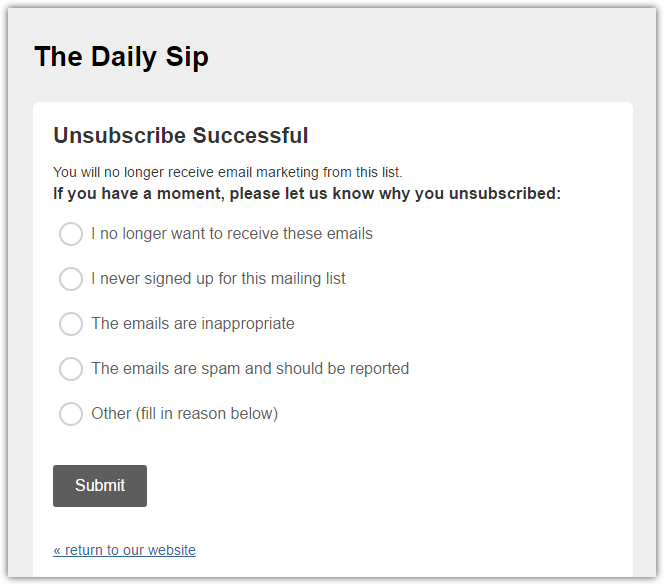 The Daily Sip asks users why they unsubscribed
The Daily Sip asks users why they unsubscribed
If you haven’t found a bulk email service or form builder to gather information about your customers, look no further. With SendPulse, you can create email campaigns and subscription forms on a single platform — the hardest you have to do is switch tabs.
Surveys
A survey is an efficient tool for receiving fresh data from your subscribers. Thanks to their interactivity, surveys liven up monotonous emails and increase audience engagement.
You can put surveys to good use to obtain information from your subscribers, define their preferences and interests, and create a customer profile. This knowledge will help you create content that meets the expectations and needs of your customers.
Have a look at how Airbnb arranges its short survey to find out more about its hosts.
Here are some tips for writing a survey you can implement:
- state the purpose of your survey right away so that your clients understand what you will be doing with their personal information;
- write your questions succinctly and briefly — do not distract your recipients with unnecessarily intricate sentences and an abundance of details;
- mention the number of questions and bonus users can get in the title (“Answer five questions and get a discount”). People will be more willing to respond to your survey if they know how long it will take and what they will get in return;
- include open-ended questions that require detailed answers. You will be able to look at a problem through the eyes of your consumers and see what language and emotions they use to describe it;
- do not include hints in your survey, allowing users to respond as they see fit.
Google Analytics
Google Analytics provides information on the browsing history of your site. Use this information to segment your mailing list and attract potential customers. Knowing what pages, items, or services are popular will help you create a targeted email to improve your response rate and conversions.
In the “Audience” section, you can find useful demographic data, including the age, gender, and location of your clients. Go to the “Audience” section on the left, and you’ll see the characteristics you can use for customer profiling and segmentation.
 The “Audience” section in Google Analytics
The “Audience” section in Google Analytics
Collect data and study the automatically generated reports to gather all the basic info about your customer segments.
CRM
Subscribers’ personal info is stored in your CRM system. Integrations between existing databases and your email platform allow you to make the most of the already collected data about users and create a customer profile.
For example, here is what contacts in SendPulse’s CRM system look like:
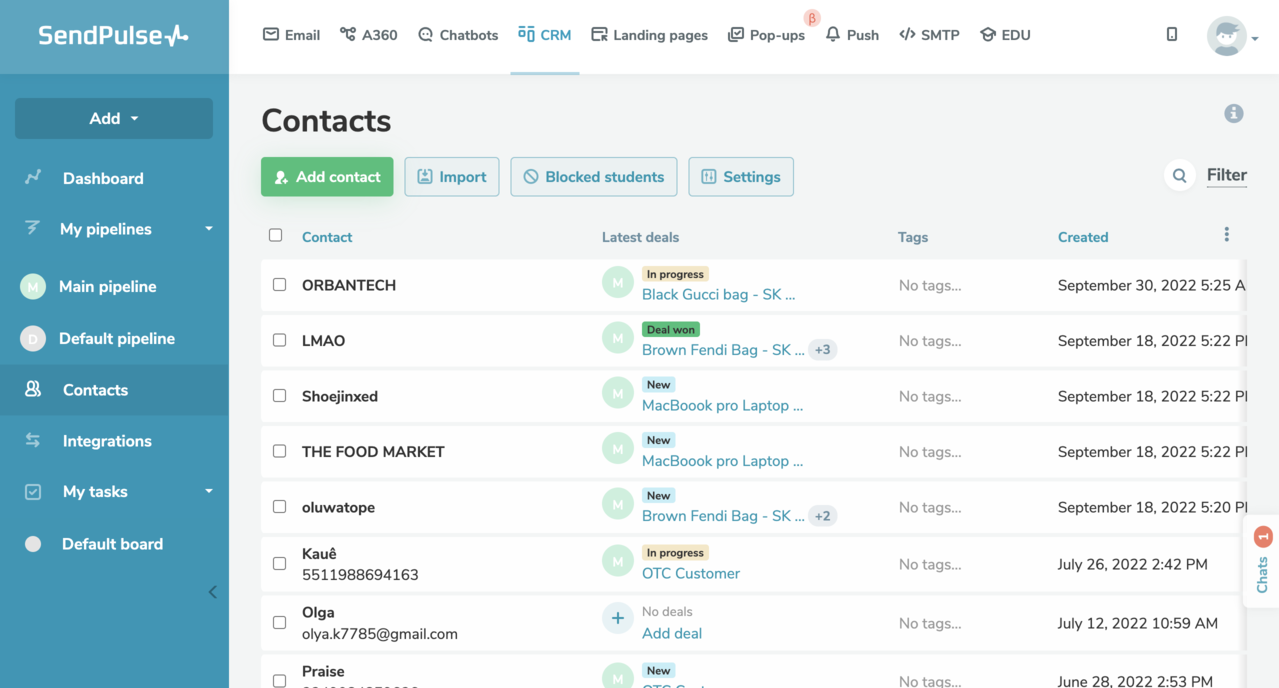 Contacts in SendPulse’s CRM system
Contacts in SendPulse’s CRM system
Take only key subscriber characteristics and data collected for the period of interaction. There will be lots of data from each sales cycle stage — you don’t need all of these points, just the parameters you singled out. Your CRM system is also an excellent source of in-depth details you can find in your sales team’s notes and comments on each customer.
Social media
One of the easiest ways to identify customers’ interests, hobbies, marital status, and personality types to create a customer profile is to view their social media accounts. In the “More” section of Facebook, you can find out about a customer’s sports, music, and movie preferences and see which brand pages they are subscribed to; on Instagram, you can scroll through their pictures to see where they have been to, who they spend their time with, and find out more about who they are as a person. The possibilities are endless here, so don’t sleep on social media as your source of data and do your research.
Call tracking and analysis
Call tracking helps your sales department track conversations with customers, as these dialogs often gleam with customer insights and valuable information you will not get anywhere else.
Find a service with dynamic call tracking that will record your conversation with customers, transform it into text, and track user information, including call date and time, clients’ phone numbers, and their location.
If you integrate a call-tracking tool with your CRM software for better customer profiling and segmentation, the system will add a new client or link a call to an existing customer. It helps analyze customers’ questions, struggles, and motivations and select the necessary information for your customer profiles.
Customer interviews
To understand customers’ challenges and drives in a way that no call, survey, or social media platform will allow you to, you can bring out the big guns and conduct an in-depth customer interview. This will require lots of preparation and rewards for your customers, but it will be worth it in the end.
Not a lot of people agree to such interviews, so finding the people for it will take some serious convincing and elbow grease. Consider developing your questions with a psychology expert or even inviting them to the interview — this will help you manage the conversation without being intrusive or making your customers uncomfortable while still getting the information you need for customer profiling.
To get people to actually participate, gather a focus group of your customers. Offer them a unique and lucrative reward that you normally don’t give away, for example, a yearly subscription for free, a gift, a discount, or bonus points.
Сustomer profiling examples
Below is a customer profiling example of a girl named Georgia. She works a lot and has little time for meal prep, spending lots of money when eating out. Georgia wants to spend less money on food, start taking care of her health, and eat healthily. One more parameter that can be added to this customer profile is Georgia’s average check — food delivery services will know exactly which meals and products they can advertise to someone like her.
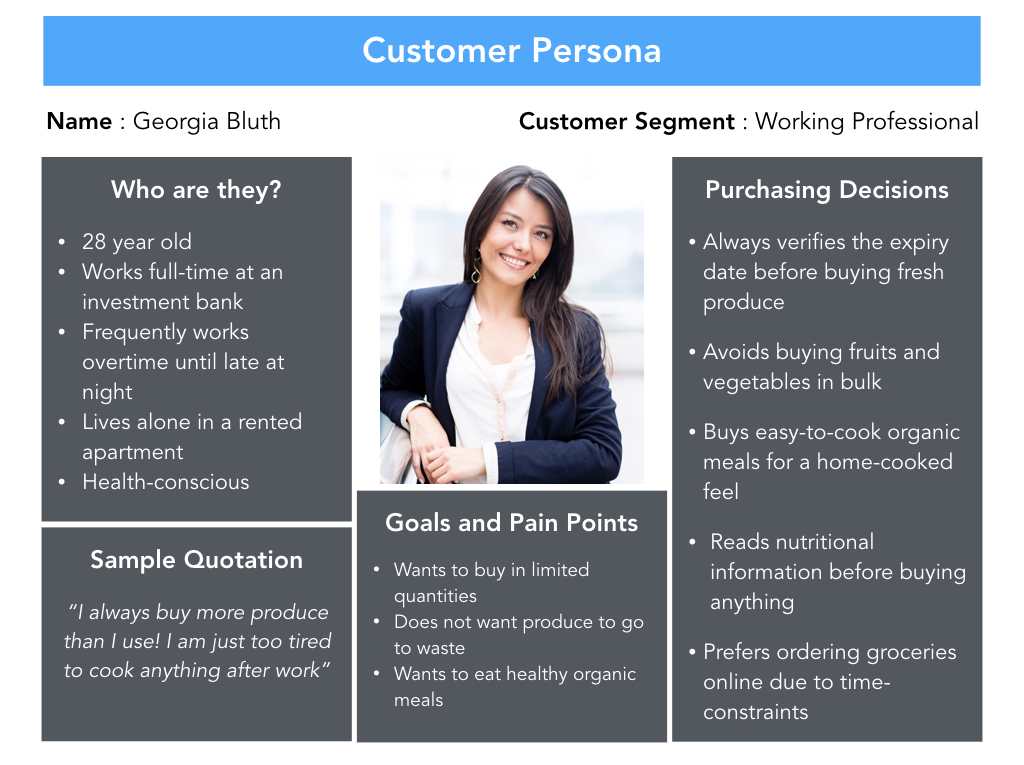 Customer profiling example
Customer profiling example
The customer profiling example below shows a profile of a programmer who wants to change his bad habits, give up alcohol, and cut junk food out of his diet. He is interested in improving his health and finding out how exercise and proper diet will affect his mood and quality of sleep. To promote a fitness app or a wellness course, you could find out more about Clark’s motivation — what drives him to adopt a healthier lifestyle, and will he be willing to stick with it?
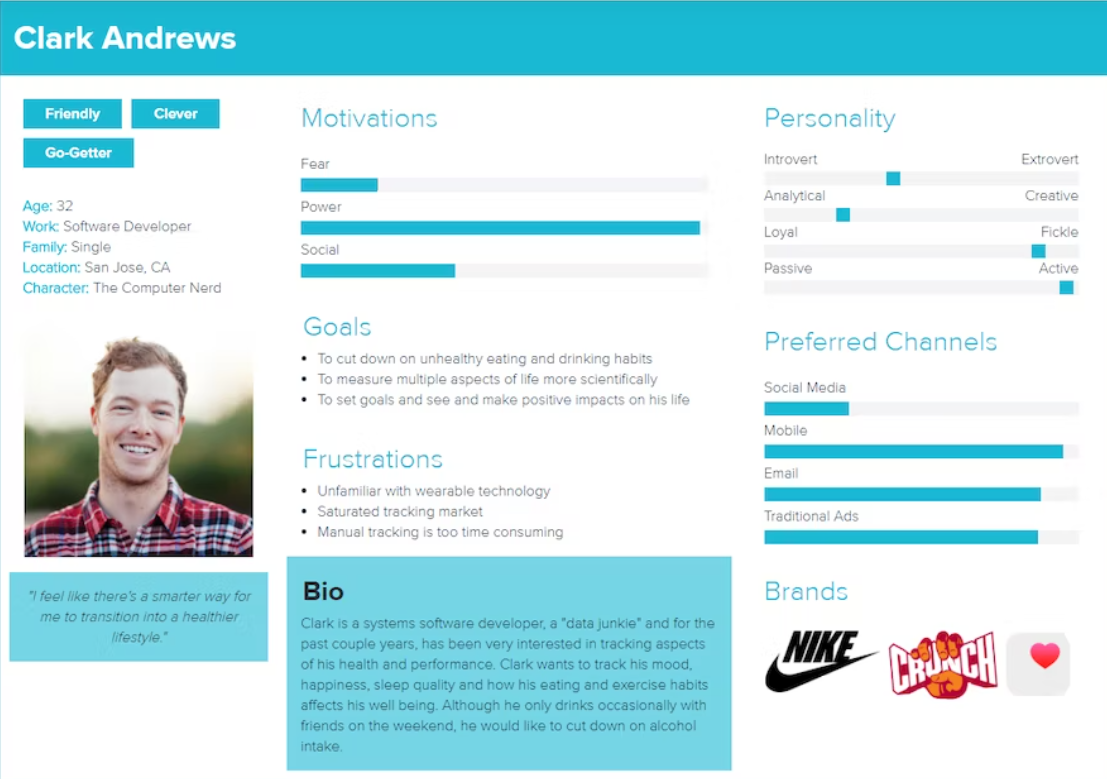 Customer profiling example; source: 99designs
Customer profiling example; source: 99designs
The customer profile below describes Wendy, a working mother. She is concerned about her family’s health but does not have enough time to take sick days often due to her tight schedule. Businesses in the healthcare industry can help her out by providing online scheduling and same-day appointments, as one of her kids can get sick unexpectedly.
Another good idea is to create online educational resources for people like Wendy, who prefer to do their research online.
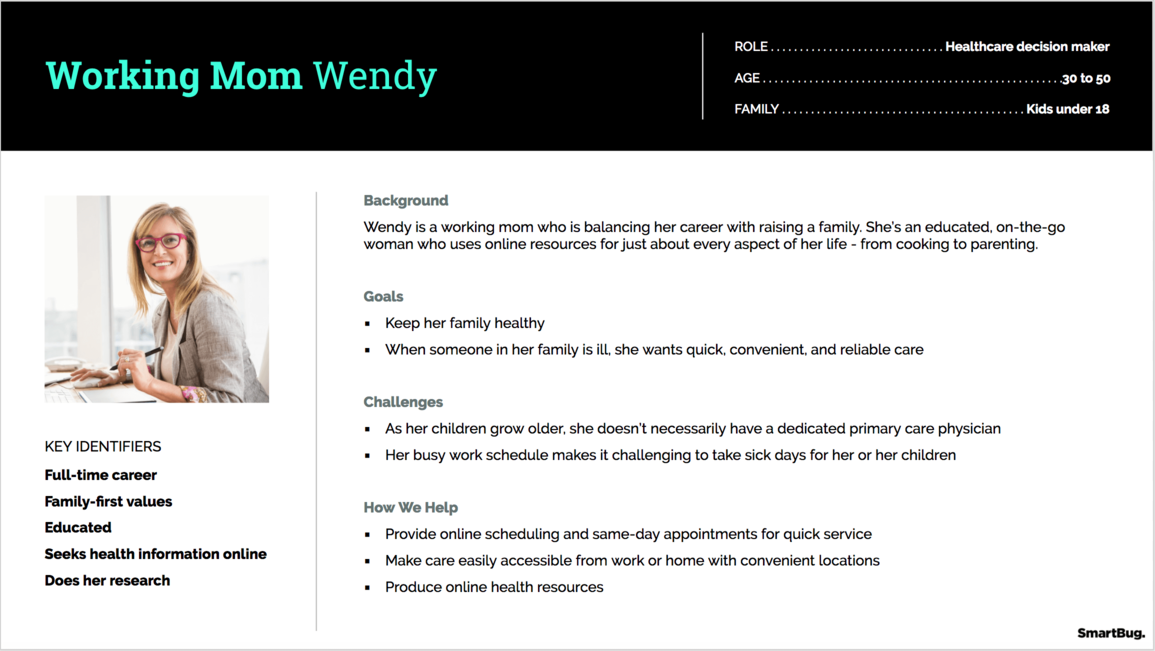 Customer profiling example; source: SmartBug
Customer profiling example; source: SmartBug
Another customer profiling example describes Heather, an older woman with health issues who strives to manage her health independently. She is not especially good with technology and the internet and often faces logistical issues when it comes to follow-up appointments. Healthcare providers can help patients like Heather by offering house call services and agreeing to visit once a week or two weeks, seeing that the woman is not able to make appointments constantly.
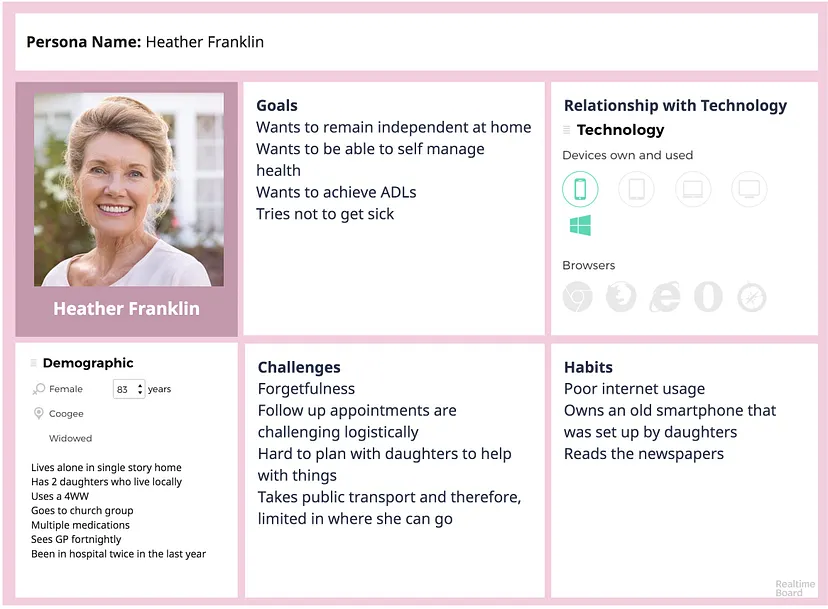 Customer profile example; source: Medium
Customer profile example; source: Medium
As you see, you don’t really need data for customer profiling in spades — only quality points that can actually help you connect with your audience better. That said, if knowing your customers’ weekly shopping list or MBTI personality type is not significant to your marketing and sales teams, do not include this info or spend your precious time gathering it.
To recap
And that’s about everything we had to teach you about this post’s key questions: what is a customer profile in marketing, and how do you build it? Let’s quickly go over the key takeaways you might want to remember:
- develop a customer profile based on the personal info of your existing customers;
- identify the kinds of data you want to collect and focus on them so as not to waste your time gathering the info you have no use of;
- use all possible sources of user info but don’t forget to inform your clients about how you plan to use their data;
- collect data using email campaigns, subscription forms, surveys, analytics tools, CRM systems, social media, call tracking tools, and customer interviews;
- build a customer profile manually or using dedicated online tools;
- update customer profiles as your audience grows.
With SendPulse, you can create email campaigns, build subscription forms, and collect customer data using a CRM system. You don’t even have to use separate tools to do this! Try it all for free and see for yourself.